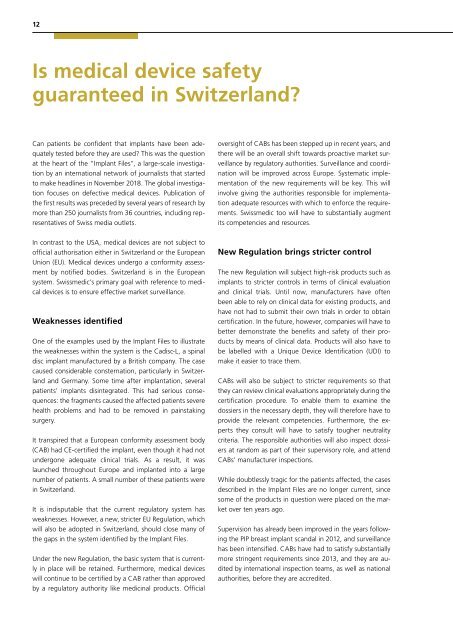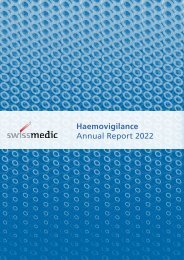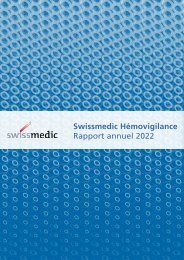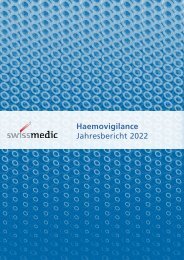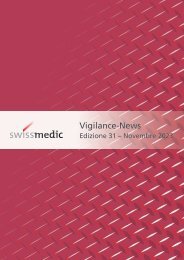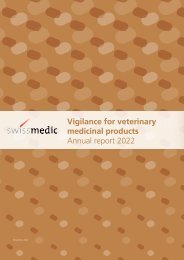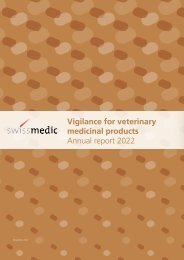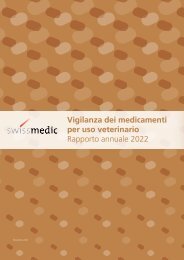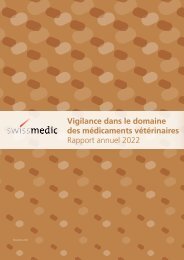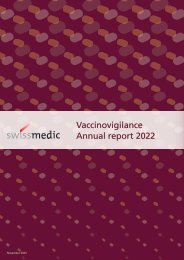Swissmedic Annual Report 2018
2018 Annual Report and annual financial statements of the Swiss Agency for Therapeutic Products (Swissmedic)
2018 Annual Report and annual financial statements of the Swiss Agency for Therapeutic Products (Swissmedic)
- No tags were found...
Create successful ePaper yourself
Turn your PDF publications into a flip-book with our unique Google optimized e-Paper software.
12<br />
Is medical device safety<br />
guaranteed in Switzerland?<br />
Can patients be confident that implants have been adequately<br />
tested before they are used? This was the question<br />
at the heart of the “Implant Files”, a large-scale investigation<br />
by an international network of journalists that started<br />
to make headlines in November <strong>2018</strong>. The global investigation<br />
focuses on defective medical devices. Publication of<br />
the first results was preceded by several years of research by<br />
more than 250 journalists from 36 countries, including representatives<br />
of Swiss media outlets.<br />
oversight of CABs has been stepped up in recent years, and<br />
there will be an overall shift towards proactive market surveillance<br />
by regulatory authorities. Surveillance and coordination<br />
will be improved across Europe. Systematic implementation<br />
of the new requirements will be key. This will<br />
involve giving the authorities responsible for implementation<br />
adequate resources with which to enforce the requirements.<br />
<strong>Swissmedic</strong> too will have to substantially augment<br />
its competencies and resources.<br />
In contrast to the USA, medical devices are not subject to<br />
official authorisation either in Switzerland or the European<br />
Union (EU). Medical devices undergo a conformity assessment<br />
by notified bodies. Switzerland is in the European<br />
system. <strong>Swissmedic</strong>’s primary goal with reference to medical<br />
devices is to ensure effective market surveillance.<br />
Weaknesses identified<br />
One of the examples used by the Implant Files to illustrate<br />
the weaknesses within the system is the Cadisc-L, a spinal<br />
disc implant manufactured by a British company. The case<br />
caused considerable consternation, particularly in Switzerland<br />
and Germany. Some time after implantation, several<br />
patients’ implants disintegrated. This had serious consequences:<br />
the fragments caused the affected patients severe<br />
health problems and had to be removed in painstaking<br />
surgery.<br />
It transpired that a European conformity assessment body<br />
(CAB) had CE-certified the implant, even though it had not<br />
undergone adequate clinical trials. As a result, it was<br />
launched throughout Europe and implanted into a large<br />
number of patients. A small number of these patients were<br />
in Switzerland.<br />
It is indisputable that the current regulatory system has<br />
weaknesses. However, a new, stricter EU Regulation, which<br />
will also be adopted in Switzerland, should close many of<br />
the gaps in the system identified by the Implant Files.<br />
Under the new Regulation, the basic system that is currently<br />
in place will be retained. Furthermore, medical devices<br />
will continue to be certified by a CAB rather than approved<br />
by a regulatory authority like medicinal products. Official<br />
New Regulation brings stricter control<br />
The new Regulation will subject high-risk products such as<br />
implants to stricter controls in terms of clinical evaluation<br />
and clinical trials. Until now, manufacturers have often<br />
been able to rely on clinical data for existing products, and<br />
have not had to submit their own trials in order to obtain<br />
certification. In the future, however, companies will have to<br />
better demonstrate the benefits and safety of their products<br />
by means of clinical data. Products will also have to<br />
be labelled with a Unique Device Identification (UDI) to<br />
make it easier to trace them.<br />
CABs will also be subject to stricter requirements so that<br />
they can review clinical evaluations appropriately during the<br />
certification procedure. To enable them to examine the<br />
dossiers in the necessary depth, they will therefore have to<br />
provide the relevant competencies. Furthermore, the experts<br />
they consult will have to satisfy tougher neutrality<br />
criteria. The responsible authorities will also inspect dossiers<br />
at random as part of their supervisory role, and attend<br />
CABs’ manufacturer inspections.<br />
While doubtlessly tragic for the patients affected, the cases<br />
described in the Implant Files are no longer current, since<br />
some of the products in question were placed on the market<br />
over ten years ago.<br />
Supervision has already been improved in the years following<br />
the PIP breast implant scandal in 2012, and surveillance<br />
has been intensified. CABs have had to satisfy substantially<br />
more stringent requirements since 2013, and they are audited<br />
by international inspection teams, as well as national<br />
authorities, before they are accredited.


